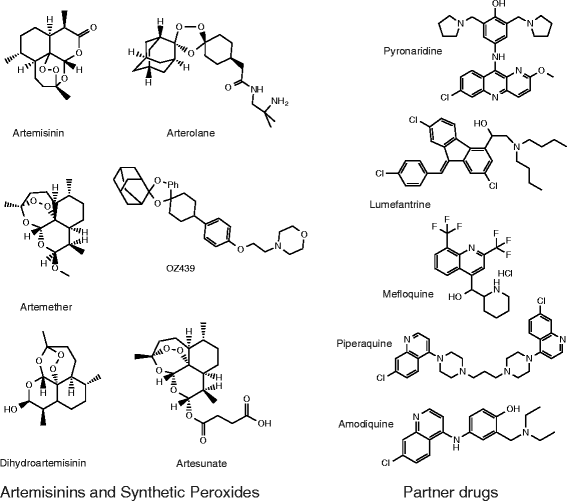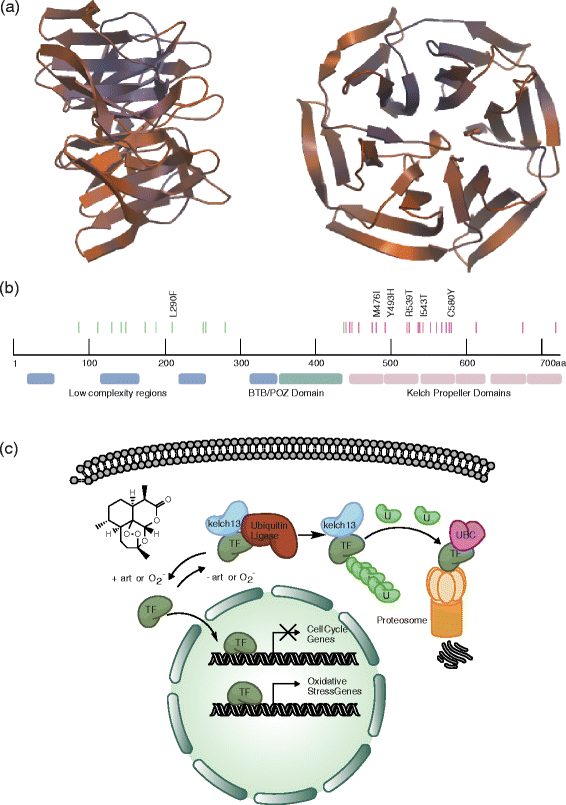Drug resistance genomics of the antimalarial drug artemisinin
- PMID: 25470531
- PMCID: PMC4283579
- DOI: 10.1186/s13059-014-0544-6
Drug resistance genomics of the antimalarial drug artemisinin
Abstract
Across the globe, over 200 million annual malaria infections result in up to 660,000 deaths, 77% of which occur in children under the age of five years. Although prevention is important, malaria deaths are typically prevented by using antimalarial drugs that eliminate symptoms and clear parasites from the blood. Artemisinins are one of the few remaining compound classes that can be used to cure multidrug-resistant Plasmodium falciparum infections. Unfortunately, clinical trials from Southeast Asia are showing that artemisinin-based treatments are beginning to lose their effectiveness, adding renewed urgency to the search for the genetic determinants of parasite resistance to this important drug class. We review the genetic and genomic approaches that have led to an improved understanding of artemisinin resistance, including the identification of resistance-conferring mutations in the P. falciparum kelch13 gene.
Figures



Similar articles
-
How genomics is contributing to the fight against artemisinin-resistant malaria parasites.Acta Trop. 2015 Aug;148:1-7. doi: 10.1016/j.actatropica.2015.04.007. Epub 2015 Apr 21. Acta Trop. 2015. PMID: 25910626 Review.
-
Artemisinin-Resistant Plasmodium falciparum Malaria.Microbiol Spectr. 2016 Jun;4(3):10.1128/microbiolspec.EI10-0013-2016. doi: 10.1128/microbiolspec.EI10-0013-2016. Microbiol Spectr. 2016. PMID: 27337450 Free PMC article. Review.
-
Artemisinin Action and Resistance in Plasmodium falciparum.Trends Parasitol. 2016 Sep;32(9):682-696. doi: 10.1016/j.pt.2016.05.010. Epub 2016 Jun 9. Trends Parasitol. 2016. PMID: 27289273 Free PMC article. Review.
-
A Kelch13-defined endocytosis pathway mediates artemisinin resistance in malaria parasites.Science. 2020 Jan 3;367(6473):51-59. doi: 10.1126/science.aax4735. Science. 2020. PMID: 31896710
-
Artemisinin Resistance and Stage Dependency of Parasite Clearance in Falciparum Malaria.J Infect Dis. 2019 Apr 16;219(9):1483-1489. doi: 10.1093/infdis/jiy673. J Infect Dis. 2019. PMID: 30657916 Free PMC article.
Cited by
-
Prevalence of K13-propeller gene polymorphisms among Plasmodium falciparum parasites isolated from adult symptomatic patients in northern Uganda.BMC Infect Dis. 2016 Aug 19;16(1):428. doi: 10.1186/s12879-016-1777-7. BMC Infect Dis. 2016. PMID: 27543172 Free PMC article.
-
From within host dynamics to the epidemiology of infectious disease: Scientific overview and challenges.Math Biosci. 2015 Dec;270(Pt B):143-55. doi: 10.1016/j.mbs.2015.10.002. Epub 2015 Oct 16. Math Biosci. 2015. PMID: 26474512 Free PMC article. Review.
-
Next-Generation Sequencing of Plasmodium vivax Patient Samples Shows Evidence of Direct Evolution in Drug-Resistance Genes.ACS Infect Dis. 2015 Aug 14;1(8):367-79. doi: 10.1021/acsinfecdis.5b00049. Epub 2015 Aug 3. ACS Infect Dis. 2015. PMID: 26719854 Free PMC article.
-
A broad analysis of resistance development in the malaria parasite.Nat Commun. 2016 Jun 15;7:11901. doi: 10.1038/ncomms11901. Nat Commun. 2016. PMID: 27301419 Free PMC article.
-
Monitoring artemisinin resistance in Plasmodium falciparum: comparison of parasite clearance time by microscopy and real-time PCR and evaluation of mutations in Pfatpase6 gene in Odisha state of India.Parasitol Res. 2015 Sep;114(9):3487-96. doi: 10.1007/s00436-015-4577-x. Epub 2015 Jun 27. Parasitol Res. 2015. PMID: 26113507
References
-
- Murray CJ, Ortblad KF, Guinovart C, Lim SS, Wolock TM, Roberts DA, Dansereau EA, Graetz N, Barber RM, Brown JC, Wang H, Duber HC, Naghavi M, Dicker D, Dandona L, Salomon JA, Heuton KR, Foreman K, Phillips DE, Fleming TD, Flaxman AD, Phillips BK, Johnson EK, Coggeshall MS, Abd-Allah F, Abera SF, Abraham JP, Abubakar I, Abu-Raddad LJ, Abu-Rmeileh NM, et al. Global, regional, and national incidence and mortality for HIV, tuberculosis, and malaria during 1990–2013: a systematic analysis for the Global Burden of Disease Study 2013. Lancet. 2014;384:1005–1070. doi: 10.1016/S0140-6736(14)60844-8. - DOI - PMC - PubMed
-
- World Health Organization . World malaria report 2013. Geneva: WHO; 2013.
-
- Looareesuwan S, Viravan C, Webster HK, Kyle DE, Hutchinson DB, Canfield CJ. Clinical studies of atovaquone, alone or in combination with other antimalarial drugs, for treatment of acute uncomplicated malaria in Thailand. Am J Trop Med Hyg. 1996;54:62–66. - PubMed
Publication types
MeSH terms
Substances
Grants and funding
LinkOut - more resources
Full Text Sources
Other Literature Sources

